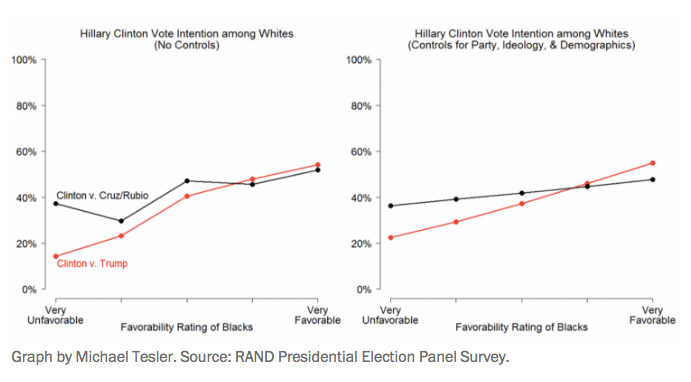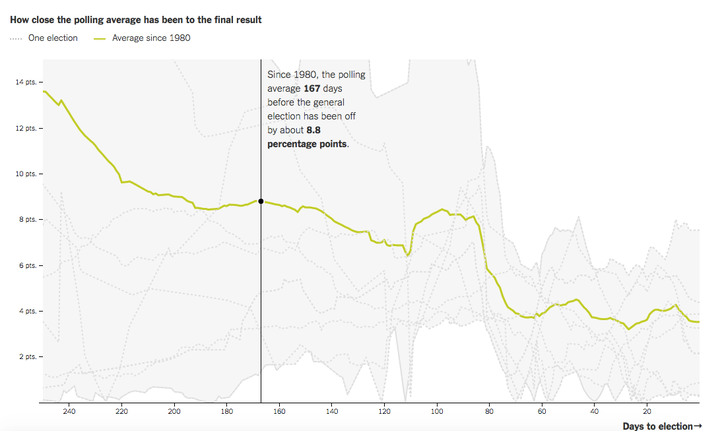County-level analysis shows just how much the country is split across geographic lines. Demographics continue to affect the election. And Donald Trump has the support of nearly half of veterans and their families. This is HuffPollster for Thursday, May 26, 2016.
AMERICA HAS A HUGE RURAL/URBAN DIVIDE - Chuck Todd, Mark Murray, and Carrie Dann: "Clinton is crushing Trump among registered voters in urban areas (58%-33%), while Trump is ahead of Clinton by an even bigger margin in rural areas (60%-29%). The suburb vote is split, 44%-44%. This divide is even more pronounced using the county-by-county work by our colleague Dante Chinni. When Chinni plugged the NBC/WSJ poll into his county-level breakdown, he found that Clinton is already matching Obama's 2012 performance in the Big Cities and the Urban Suburbs, and Trump is surpassing Mitt Romney's '12 performance in Rural America. Interestingly, where Clinton is underperforming is in the college towns (Books and Barracks Counties -- hello, Bernie Sanders!), and where Trump is underperforming is in Faith Driven America. But when Trump goes into Urban America -- as he did last night in Albuquerque, NM with a significant Latino population -- you see why you get the protests and unrest that occurred. This country couldn't be more divided between Urban America and Rural America." [NBC]
RACIAL PREJUDICE COULD INFLUENCE VOTES IN NOVEMBER TOO - Michael Tesler: "Attitudes about racial and ethnic groups helped fuel Donald Trump’s apparent victory in the Republican presidential primary….But whether attitudes about race and ethnicity will matter in November’s general election is a different question….If Trump’s candidacy has the same impact in 2016 (compared to 2008 when Obama's presence caused racial attitudes to emerge) then we should also see a stronger impact of racial attitudes in a Clinton-Trump match-up than if Clinton were facing Republicans like Ted Cruz and Marco Rubio. That’s exactly what the graphs below show: The left-hand graph shows that the relationship between attitudes about blacks and support for Clinton was stronger when she was matched up against Trump than it was when she was matched up against Ted Cruz and Marco Rubio….The right-hand graph shows that the same finding emerges even after accounting for party identification, ideological identification, and other demographic characteristics." [WashPost]

Gender could also influence votes - Sean Trende: "The gender gap is an inherent, long-standing force in American politics. It does not, however, always work to Democrats’ advantage… [C]onsider the case of Mark Udall in Colorado. Udall was elected to the Senate in 2008...When he ran unsuccessfully for re-election in 2014, the environment was very different...Udall decided to take a page from previous Democratic playbooks ...and play heavily to groups that tended to lean Democratic, emphasizing women…. Despite the massive shift in the national environment, he only dropped four points among women. The problem is, the focus on women’s issues probably backfired among men. Udall plummeted from 52 percent of the male vote [in 2008] to just 41 percent. In the end, his overall vote share dropped seven points, similar to the shift in the national House vote of nine points." [RCP]
ELECTION RESULTS PROBABLY WON'T LOOK LIKE TODAY'S POLLING AVERAGES - Josh Katz and Kevin Quealy: "Since Donald Trump became the presumptive Republican nominee, several national polls have shown him narrowing the gap with his likely opponent, Hillary Clinton, or even leading. But the election is more than five months away. When should you start to care about polls? With some caveats, we believe the answer is: not quite yet. The chart above shows how much the polling average at each point of the election cycle has differed from the final result. Each gray line represents a presidential election since 1980. The bright green line represents the average difference. At this point – 167 days before the election – a simple polling average has differed from the final result by about nine percentage points. We expect this average to become more meaningful by the week, until the national party conventions temporarily make it less so, as shown in the bump about 100 days before the election. The average difference begins to flatten about two months before the election. The day before the voting, an unadjusted polling average has been about 3.5 points off the final result." [NYT]

As the polls shift, so will averages - Just a couple of days ago, the HuffPost Pollster chart for Trump vs. Clinton showed the average margin between the two had narrowed to about 1.5 percentage points. Now it’s showing Clinton up by nearly 4 points. Trump’s numbers dropped because a few new polls with large sample sizes have shown him in the 40-42 percent range, compared to polls last week that had him at 44-46 percent. The chart's statistical algorithm takes sample size into account in the calculations, so these large polls have considerable pull on the average and force a downward trend for Trump. The current estimate of 39.2 percent for Trump is slightly lower than his standing in most recent polls because of the downward pull of those surveys. For an alternate view, customize the chart by selecting “less smoothing.” That view has Trump just about a percentage point behind Clinton. But as polls are unstable, polling averages will be unstable, so it’s best not to make any firm conclusions about the state of the race between Trump and Clinton right now.
NEW SURVEY SHOWS CLINTON LOSING HER LEAD IN CALIFORNIA - Scott Shafer: "As state election officials report surging voter interest in the June 7 primary, a new poll from the Public Policy Institute of California shows that Vermont Sen. Bernie Sanders has closed the gap against Hillary Clinton in the race for the Democratic nomination. Among likely voters in the Democratic primary, the PPIC poll shows Clinton and Sanders essentially tied in California, with Clinton winning 46 percent support to 44 percent for Sanders. That’s within the poll’s margin of error." The PPIC results, if not an outlier, represent significant last-minute movement in the race. Prior to the poll's release, HuffPost Pollster's average gave Clinton an average 17-point margin over Sanders, 56 percent to 39 percent. The institute's previous poll, conducted in March, also gave Clinton a relatively-narrow 7 point lead. [KQED, California chart]
VETERAN HOUSEHOLDS PREFER TRUMP TO CLINTON - Cameron Easley: "The news on Donald Trump and veterans hasn’t been very flattering this week, but recent Morning Consult surveys show that members of the military and their families largely back the presumptive GOP nominee in the race for the White House. Almost half of veterans and voters who belong to veteran households (47 percent) picked Donald Trump as their presidential nominee in surveys taken from May 13 through May 24. Of the 1,668 military voters polled, only 38 percent support former Secretary of State and first lady Hillary Clinton, the likely Democratic nominee." [Morning Consult]
HUFFPOLLSTER VIA EMAIL! - You can receive this daily update every weekday morning via email! Just click here, enter your email address, and click "sign up." That's all there is to it (and you can unsubscribe anytime).
RECENT POLLS
-Hiillary Clinton expands her national primary lead against Bernie Sanders. [YouGov]
-Clinton outperforms Donald Trump among middle-income Rust Belt voters. [Bloomberg]
-American views on abortion have remained steady in the past year. [Gallup]
-A majority of Democrats and Republicans support drug testing at work. [YouGov]
THURSDAY'S 'OUTLIERS' - Links to the best of news at the intersection of polling, politics and political data:
-Doyle McManus explains why Democrats shouldn't worry about polls that show Donald Trump and Hillary Clinton tied. [LA Times]
-Harry Enten doubts Sanders' popularity among true independents. [538]
-Kyle Kondik and Geoffrey Skelley explain why a Libertarian candidate might not perform very well. [UVA Center for Politics]
-One in two Americans say they wouldn't be able to cover an unexpected $400 expense. [WashPost]
-The Center for Disease Control finds that Americans are growing increasingly obese. [CNN]